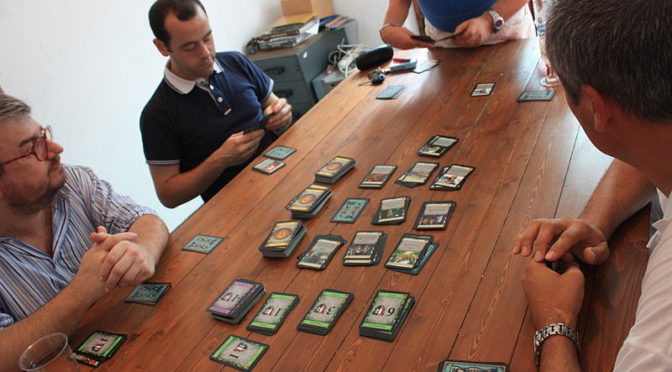This is an excerpt from my ebook, How to Design Card Games.
Card games typically have different areas in front of the players. These areas have a variety of names, depending on their purpose:
- Arena – A common area to which players play cards face up to a contest, such as a “battle” or “war” in the game of War.
- Cascade – A set of face-up cards built on one another, with the value and suit of each card in the cascade visible. (For instance, Solitaire builds 7 cascades, from highest to lowest.)
- Cell – A spot that can hold only one card.
- Community Card – A face-up card whose properties or value are shared by all players.
- Discard Pile – An area where cards are placed that have been used or can’t be used. Typically played face up, though some games require the cards to be played face down. Also known as trash or waste. Some games cascade the discards, which can be drawn from.
- Draw Pile – The deck of cards to draw from, typically face down.
- Foundation – A face-up pile that cards are played to. For instance, in Solitaire, there is a foundation started by the Ace of each suit.
- Grid – A rectangle of cells. For instance, in Concentration, 4 rows of 13 face-down cards each (the entire deck, excluding Jokers).
- Hand – The cards dealt to a player, typically face down, and known only to the player, who can look at all of them.
- Hole Card – A card dealt to a player face down and not revealed to other players until the end of the hand.
- Kitty – Additional cards dealt face down to the center of the table.
- Layout – The cards played face up in front of a player and specific to that player. For instance, in Solitaire, the 7 cascades. Another word for layout is tableau.
- Pot – The amount of chips that can be won this round. Usually played to the center.
- Stack – A draw pile turned upside down, with the top card visible. Each time a card is taken the next card is revealed.
- Stock – A face-down draw pile available only to a particular player, as in War or Simultaneous Solitaire.
- Upcard – A card or group of cards dealt to an individual player face up.
Each area might represent a different part of the theme. Your game might have multiples of any one of these, with different names. For instance, a dungeon-exploring game might have a Room draw pile, a Monster draw pile, and a Treasure draw pile. A player might have a Left-handed Weapon cell and a Right-handed Weapon cell and an Armor cell. A player playing a Wizard might have a spell stock. And so on.
| Usable by All Players | Usable by Specific Player | |
| Face-Down Group | (Draw Piles) | – |
| Face-Down Pile | Draw Pile &
Kitty |
Stock & Hand |
| Face-Down Card | Grid | Hole Card |
| Face-Up Group | Arena & Community Cards |
Layout |
| Face-Up Pile | Discard Pile & Foundation & Stack |
Cascade |
| Face-Up Card | Cell | Upcard |
| Other Components | Pot | – |
Many games have actions that involve moving cards between areas. Here are some common actions players can take:
- Burn – Discard the top card of a stack.
- Cover – Play a higher card of any suit.
- Crawl – Play a higher card of the same suit.
- Deal – Move cards from the draw pile to each player’s hand.
- Discard – Move a card from a player’s hand to a discard pile.
- Draw – Take a card from the draw pile and add it the player’s hand.
- Go out – Get rid of all the cards in a player’s hand in a game where that specifies an ending condition.
- Hit – To take another card from the dealer face up to a player’s layout.
- Layoff – To move cards from your hand to a rival’s layout.
- Pass – To not play a card on your turn but let the next player know they can go.
- Show – Turn a face-down card face up for all to see, then place it face down again.
- Shuffle – Mix the cards together multiple times to randomize the order. Often used when making a discard pile a new draw pile.
- Stand – To decide not to draw any more cards for the rest of the round.
Using these terms, and ways of thinking about card games, you can come up with specific actions for your own card game such as “Steal” (move a card in a rival’s layout to your hand), “Destroy” (move a card in a rival’s layout to the discard pile), “Damage” (move a card in a rival’s layout to their hole cards), and “Level” (move a card in a rival’s layout to their hand).
(Photo by Moroboshi, used by permission.)


